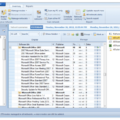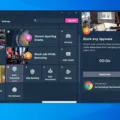Are you looking for an easy way to monitor your network traffic and better understand what’s happening on your Windows system? Windows Network Monitor is the perfect tool for the job. With this powerful utility, you can easily keep track of what’s going on in your network environment and identify potential issues.
Network Monitor has been around since Windows Vista, but the newest version included with Windows 10 is much more comprehensive. It enables users to capture, view, and analyze network data so they can troubleshoot any problems they may be having with their applications or other network components.
When you open Network Monitor in Windows 10, it will display all available network adapters on your system. You can then select the ones you want to monitor and start a new capture to start tracking data. Once you have reproduced the issue you are trying to address, Network Monitor will grab all relevant packets from the wire and show them in a detailed list. This allows you to easily inspect each packet’s header information and content so that you can identify any potential issues.
One of the great things about Network Monitor is that it can be used alongside other monitoring solutions like Wireshark or Microsoft Message Analyzer for an even more advanced analysis of your network traffic. You can also use it with tools such as Microsoft Sysinternals Process Monitor and Autoruns to get a full picture of what’s going on in your system at any given time.
Network Monitor really is an invaluable tool for anyone who needs to keep an eye on their network traffic or diagnose any issues they may be having with their applications or other components. If you haven’t taken advantage of its features yet, now is certainly the time to do so!
Monitoring Network Performance in Windows 10
Yes, Windows 10 does have a network monitor. The built-in network usage monitor is a helpful tool that can be used to keep track of your bandwidth consumption. It works by displaying data such as the amount of data sent and received over your connection, the applications using the most data, and the amount of data being uploaded or downloaded. This information can be used to identify any apps or services that may be consuming more bandwidth than necessary, or if your connection is being overused and needs to be throttled back. In addition, you can also use the network monitor to compare your current usage to past records, so that you can get an idea of how much data you are using in relation to previous periods. Overall, this is a great way for users to gain insight into their network usage and take greater control over their internet experience on Windows 10.

Source: bleepingcomputer.com
Monitoring Network Traffic in Windows
To monitor network traffic in Windows, you can use the Network Monitor tool. To use it, first open Network Monitor in an elevated status by right-clicking the Network Monitor icon and selecting “Run as Administrator”. Once opened, select the network adapters where you want to capture traffic, then click on “New Capture” and finally click on “Start”. Reproduce the issue, and you’ll see that Network Monitor will grab all of the packets on the wire.
The Functionality of Microsoft Network Monitor
Microsoft Network Monitor is a powerful protocol analyzer that enables you to capture, view, and analyze network data in order to help troubleshoot problems with applications on the network. It allows users to capture packets of data across multiple networks, decodes them into their respective protocols, and view the frames in a convenient way. Additionally, Network Monitor includes tools for filtering and creating summary statistics so users can quickly identify patterns or anomalies in network traffic. With these features, users can quickly isolate the source of network-related issues such as slow performance or dropped connections.
Monitoring an Entire Network
Monitoring your entire network is relatively easy. The first step is to log into your router. You can do this by entering your router’s IP address into a web browser and signing in. Once you’re logged in, you’ll want to look for a Status or Bandwidth/Network Monitor section depending on the type of router you have. This will provide you with an overview of all the devices connected to your network, including their IP addresses, as well as other useful information such as upload/download speeds and usage levels. Additionally, there are several third-party applications and services available that allow you to monitor your entire network from one centralized location, giving you even more insight and control over how it operates.
Viewing All Computers Connected to a Network
In order to view all computers connected to your network, you will need to open the Command Prompt on your computer. To do this, simply type ‘CMD’ into the search box and click ‘Run as Administrator’ from the menu. Once you have opened the Command Prompt, type in ‘net view’ and press enter. This will give you a list of all devices connected to your network. If you would like more detailed information about each device, you can use the ‘netstat -a’ command which will give you more detailed information about each device such as their IP address and MAC address. You can also use a third-party application such as Advanced IP Scanner or Angry IP Scanner to provide a graphical interface for finding and managing devices on your network.

Source: youtube.com
Can Network Administrators Monitor Network Traffic?
Yes, network administrators can see traffic on a network. By analyzing the data packets sent across the network, they can get an idea of the types of activities being performed. This includes information such as which websites are being visited, who is accessing those websites, how much data is being transferred, and when the activity is taking place. Network administrators may also be able to monitor specific computers or IP addresses for suspicious activity.
Monitoring Local Network Usage
Monitoring local network usage can be a tricky task, but it is important to do in order to ensure that your network is running as efficiently as possible.
The first step in monitoring your local network usage is to check the bandwidth usage of your router. Most routers have an administrative interface that you can access through a web browser or a mobile app, which will allow you to view your current bandwidth consumption. You can also use tools like Capsa to monitor the traffic on your network and identify any unusual activity.
If you suspect that malware could be using up resources on your local network, it would be wise to run a scan with a reliable anti-malware program. This will help you identify any malicious software that could be consuming bandwidth and slowing down your system.
You can also use the Windows Resource Monitor tool to check for any suspicious network activity. The Resource Monitor will show you what applications are currently using the most bandwidth, so you can quickly identify any programs or services that may be taking up too much of your bandwidth allocation.
Finally, the Netstat command line utility can provide detailed information about how data packets are flowing through your local area network. With this information, you should be able to identify any bottlenecks or other issues with your local network traffic.

Source: windowsreport.com
The Need for Network Performance Monitoring
Network performance monitoring is essential to ensure that a network’s performance meets the needs of its users and the organization at large. Without monitoring, it can be difficult to identify problems or inefficiencies within a network that may be causing slowdowns or other issues. Network performance monitoring can also help identify areas of improvement for future network architectures, as well as provide insight into where resources should be allocated to best serve the organization’s needs.
Network performance monitoring can also help increase security by detecting malicious activity on the network and alerting administrators to potential breaches or intrusions. By identifying weak points or vulnerabilities in the network architecture, administrators can take steps to harden their networks and make them less vulnerable to attack. Additionally, tracking user behavior over time can help detect anomalous activity that could indicate malicious intent.
Finally, with detailed data about the performance of a network, administrators can more easily troubleshoot issues when they arise and quickly resolve them before they impact users or operations. This helps reduce downtime and ensures time-sensitive tasks are completed with minimal disruption.
Is Network Monitor Essential for Networking?
Network monitoring is an essential process for any network, large or small. Without it, organizations can find themselves in serious trouble if something goes wrong with their network. Network monitoring helps to identify problems quickly and take corrective action before they become major issues. It also allows administrators to optimize their networks by analyzing traffic patterns and identifying potential bottlenecks or areas of concern that need to be addressed. Finally, network monitoring can help organizations become more secure by providing visibility into suspicious activity and alerting administrators of any potential malicious activity. Therefore, having a robust network monitoring solution in place is essential for every network.
Monitoring Network Traffic for Free
Monitoring your network traffic for free is possible with a wide range of tools available. SolarWinds ipMonitor Free Edition is one of the most popular free tools on the market and allows users to monitor network performance, availability, bandwidth utilization, and more. It also offers advanced alerting and reporting capabilities. Paessler PRTG Network Monitor also offers a free edition that has over 200 sensors for monitoring your entire IT infrastructure. Site24x7 Server Monitoring is another excellent option, offering up to 25 monitors for free. ManageEngine OpManager offers a 30-day trial period so you can try out their network monitoring capabilities without spending any money upfront. Domotz also offers a 30-day trial period that allows you to monitor all your connected devices on your home or office network. LibreNMS, Prometheus, and Zabbix are three other great options that offer open-source network monitoring solutions that are completely free to use.
Conclusion
In conclusion, Windows Network Monitor is an incredibly useful tool for monitoring network activity and analyzing data on your system. With its easy-to-use interface, customizable settings, and powerful features, it can provide a comprehensive view of your network’s health and performance. It is also highly configurable and can be used to diagnose and troubleshoot network issues. Whether you are a network administrator or just a casual user, Windows Network Monitor offers a great way to stay on top of your system’s performance.








